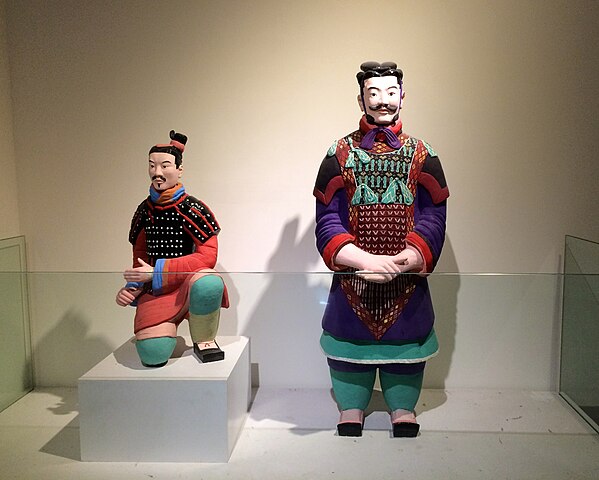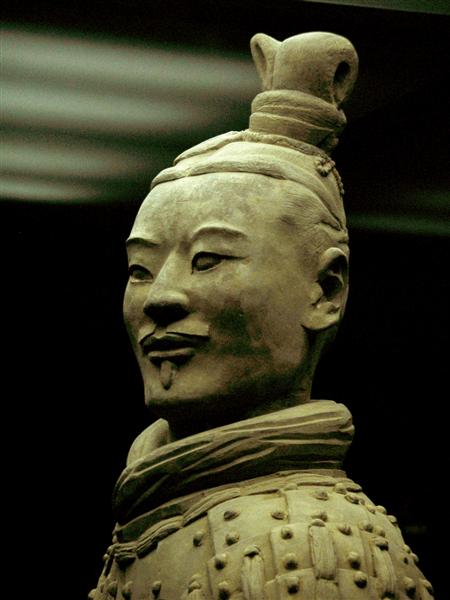
On 15 September, the Bangkok National Museum, located on Naphra That Road between Thammasat University and the National Theatre, and opposite Sanam Luang, will open an exhibition, Qin Shi Huang: The First Emperor of China and the Terracotta Warriors, which may be visited for three months.
Qin Shi Huang, whose name means First Emperor of Qin in the Chinese language, was the founder of the Qin dynasty and first emperor of unified China. His reign is noted for economic and political reforms. He had a mausoleum or tomb built that is the size of a city, guarded by a life-sized terracotta army. The exhibition at the Bangkok National Museum will include four of the life-sized warrior figures and a bronze chariot, among other artifacts excavated from the tomb.
For TU students interested in history, China, art, political science, and related fields, this exhibit should be very informative. The TU Library owns a number of books about Qin Shi Huang and his terracotta army. They include Awakened: Qin’s Terra-Cotta Army; Emperor of Stone edited by Meng Jiangmin and Zhang Lin; Emperor of Stone: Qin and the Terra Cotta Armies by Glenn Fieber; The First Emperor of China by Frances Wood; The Subterranean Army of Emperor Qin Shi Huang: the Eighth Wonder of the World edited by Qin Wen and Zhao Runze; The Terracotta Warriors: The Secret Codes of the Emperor’s Army by Maurice Cotterell; as well as other books in Thai language and Chinese.
The word terracotta is an Italian term meaning baked earth, originally derived from a Latin expression meaning the same thing. It means a type of ceramic that is baked without any glaze. Terracotta sculptures have been found in Pakistan that were created up to 5000 years ago. In Ancient Greece, India, and especially China, sculptures in terracotta were popular. The terracotta army of Emperor Qin Shi Huang was unusual because most figures in terracotta were not three dimensional or life sized.

Other Chinese terracotta warriors in the Kingdom
TU students at the Faculty of Liberal Arts may have visited another place in Thailand where it is possible to see examples of the terracotta warriors. Viharn Sien is a Chinese temple south of Pattaya, now used as a museum of Chinese art. It is situated beside a lake on the Wat Yansangwararam temple complex. Among its outstanding collection are some of the terracotta warriors, horses, and chariots from the tomb of Emperor Qin Shi.
Created just over 2300 years ago, the sculptures were found in the 1970s by farmers in Lintong County, outside Xi’an, Shaanxi, China. By 2007, when they had all been examined, it was announced that three pits contained over 8,000 soldiers, 130 chariots with 520 horses, and 150 cavalry horses. There were also terracotta figures that were not soldiers, including acrobat and musicians. The terracotta warriors were once painted. Today only a few statues still have traces of paint.
The United Nations Educational, Scientific and Cultural Organization (UNESCO) placed the Mausoleum of the First Qin Emperor on the World Heritage List.
The UNESCO website explains:
No doubt thousands of statues still remain to be unearthed at this archaeological site, which was not discovered until 1974. Qin (d. 210 B.C.), the first unifier of China, is buried, surrounded by the famous terracotta warriors, at the centre of a complex designed to mirror the urban plan of the capital, Xianyan. The small figures are all different; with their horses, chariots and weapons, they are masterpieces of realism and also of great historical interest…
As the tomb of the first emperor who unified the country, it is the largest in Chinese history, with a unique standard and layout, and a large number of exquisite funeral objects. It testifies to the founding of the first unified empire- the Qin Dynasty, which during the 3rd BCE, wielded unprecedented political, military and economic power and advanced the social, cultural and artistic level of the empire.
Criterion (i): Because of their exceptional technical and artistic qualities, the terracotta warriors and horses, and the funerary carts in bronze are major works in the history of Chinese sculpture prior to the reign of the Han dynasty.
Criterion (iii): The army of statues bears unique testimony to the military organization in China at the time of the Warring Kingdoms (475-221 BCE) and that of the short-lived Empire of a Thousand Generations (221-210 BCE). The direct testimony of the objects found in situ (lances, swords, axes, halberds, bows, arrows, etc.) is evident. The documentary value of a group of hyper realistic sculptures where no detail has been neglected – from the uniforms of the warriors, their arms, to even the horses’ halters – is enormous. Furthermore, the information to be gleaned from the statues concerning the craft and techniques of potters and bronze-workers is immeasurable.
Criterion (iv): The mausoleum of Qin Shi Huang is the largest preserved site in China. It is a unique architectural ensemble whose layout echoes the urban plan of the capital, Xianyang, with the imperial palace enclosed by the walls of the city, themselves encircled by other walls. This capital of the Qin (to which succeeded on the present site of Xian the capitals of the Han, Sui and Tang dynasties) is a microcosm of the Zhongguo (Middle Country) that Qin Shi Huang wanted both to unify (he imposed throughout the land a single system of writing, money, weights and measures) and to protect from the barbarians that could arrive from any direction (the army which watches over the dead emperor faces outward from the tomb).
Criterion (vi): The mausoleum of Qin Shi Huang is associated with an event of universal significance: the first unification of the Chinese territory by a centralized state created by an absolute monarch in 221 BCE.
Integrity
The Qinshihuang Mausoleum features a high level of integrity; the grave mound, mausoleum constructions, burial pits, sites of ritual construction and overall setting in the property area and the buffer zone are well preserved, and fully reflect the structure and ritual system of the whole mausoleum.
Authenticity
The grave mound, sites of constructions, burial tombs and burial pits in Qinshihuang Mausoleum truthfully maintain their original location, material, formation,technology and structure, which authentically reflect the constricting regulation of the Mausoleum and palace life and military systems of the Qin Dynasty. The numerous unearthed cultural relics reflect the highest technical level of pottery, chariot assembly, metallurgy and metal processing in the Qin Dynasty.
Protection and management requirements
The Qinshihuang Mausoleum has been listed a State Priority Protected Site and thus is under the protection of the Law of the People’s Republic of China on the Protection of Cultural Relics. In July 2005, the Shaanxi Provincial People’s Congress passed the Shaanxi Provincial Regulation on the Protection of Qinshihuang Mausoleum and established a protection body: Qinshihuang Mausoleum. In 2009, the Museum of the Terra-Cotta Warriors and Horses of Qinshihuang was upgraded to the Qinshihuang Mausoleum Museum by the Shaanxi Provincial Bureau of Cultural Heritage, taking charge of the overall planning, management, archaeological excavation, scientific research and daily maintenance…

(All images courtesy of Wikimedia Commons)
